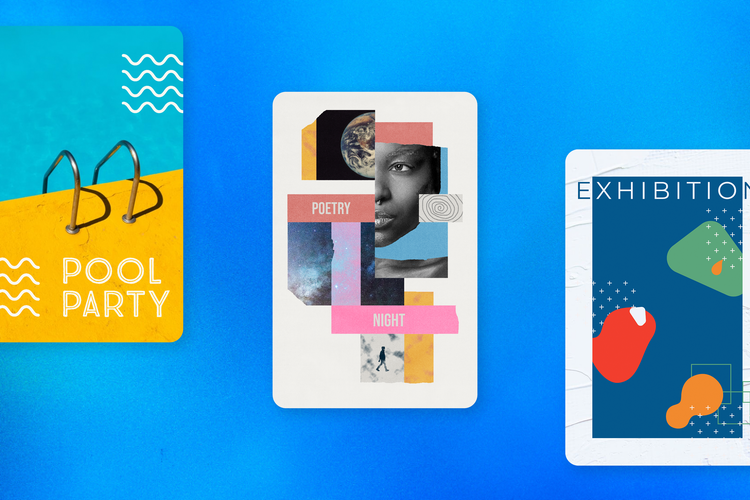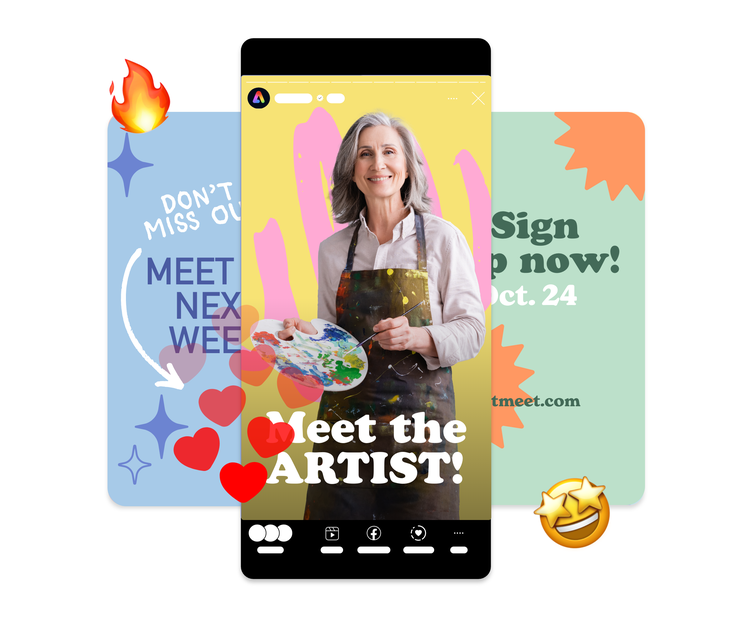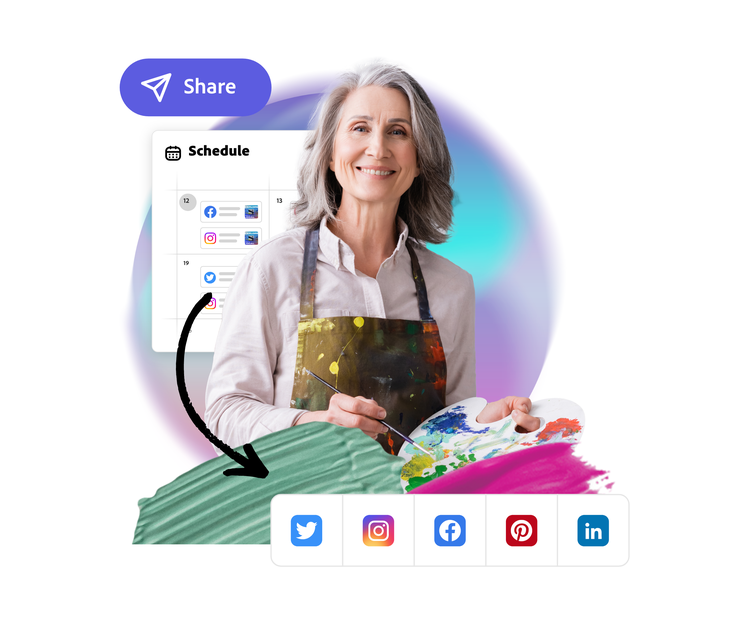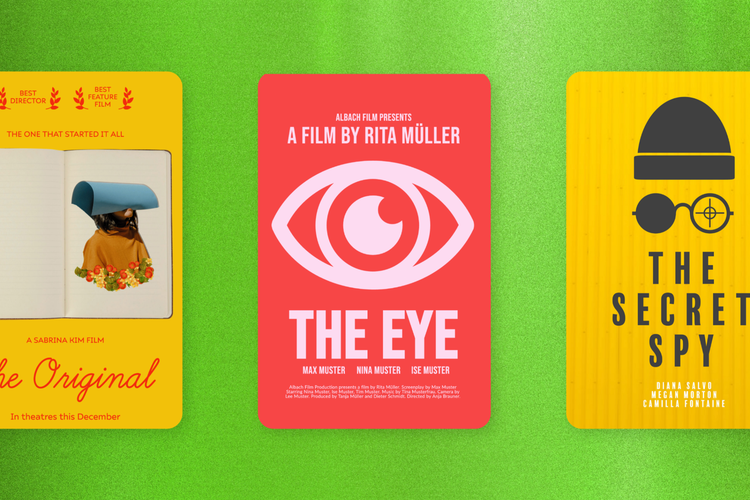A comprehensive guide to community event marketing
From 5k runs to music festivals, automate your community event promotion and increase engagement with Adobe Express.

Summary/Overview
Community events are even more powerful than you might think.
Yes, they can help you build awareness of your mission and brand, grow your email list, and raise money for a cause — but the connections made at local events also have a positive impact on individuals and communities that lasts far beyond the event.
Organizing a community event is a big undertaking, especially for an up-and-coming grassroots or nonprofit group. Whether you’re hosting a 5K race for charity, a food drive, or a block party, you’ll need to promote your event through digital, direct mail, and in-person channels while also juggling all your other responsibilities.
This ultimate guide to community event marketing for nonprofit and grassroots organizations has everything you need to know to create and execute a streamlined, actionable event marketing plan, including tips for automation. Read on to learn more about community events and how to build a marketing plan that will get your community engaged with your next event.
How community events are different
Events like outdoor concerts, street festivals, and galas are fun, and they’re good for business and fundraising — but their real power is deeper.
Community events offer health benefits that range from encouraging physical activity to improving mental health through social connection. People are social creatures, and the true power of community events is in their ability to foster a sense of belonging — which in turn builds loyalty and community around a brand or social cause.
In contrast to large national or international events, hyperlocal community events bring people together around issues and opportunities unique to a neighborhood or city. By highlighting local history, small businesses, artists, and organization members, these events build positive identity and long-term community vibrancy. For grassroots organizations, they activate existing networks, bring prospective customers or donors into the fold, and keep people talking about your mission.
Types of community events
Community events bring people together in a variety of different ways. Depending on what your organization hopes to accomplish — from fundraising to “friendraising” — there’s an event that’s perfect for your cause. Here are a few examples:
- 5k run, walk, bike, or swim
- Charity concert featuring local bands
- Food or beverage tasting in partnership with local restaurant businesses
- Black-tie gala and silent auction
- Charity golf tournament
- Movie night for families in partnership with a local theater or park
- Auction or raffle events with goods and services provided by local businesses
- Workshop or class with a local chef, artist, entrepreneur, expert, legislator, or celebrity
- Cultural celebration of the diverse people or unique history of your community
- Open mic night
- Themed block party or barbecue
Try one of these templates to get started quickly:
A step-by-step guide to community event marketing strategy
Whatever your event may be, getting the word out is essential to its success. The rest of this article provides a step-by-step guide to creating a marketing plan that will help you build awareness and relationships by bringing people together for your next community event.
Step 1: Define your community event marketing goals.
Event marketing is the strategy you use to plan, organize, and execute your event to promote awareness of your mission or brand and impact your community. The first step to an event marketing plan is to identify your goals, including how many people you want to attend your event as well as how many you want to reach with your message. Decide which metrics you’ll use to track and report.
If your goal is to raise money, set an overall target as well as goals for the number of donations and average donation amount. You may also want to set goals for other actions you hope attendees will take, such as signing up for your email newsletter or posting about the event on social media.
As part of your goal setting, create a timeline for your event marketing, including deadlines for things like securing a venue, contacting potential local partners or sponsors, creating or printing materials, and getting the word out both in person and online.
Try one of these templates to get started quickly:
Step 2: Identify your audience and messaging.
The next step is to get specific about which people in your community you’re hoping to reach. Consider age, location, interests, and other demographics that can help you get in front of an audience who will care about your event and cause.
Once you know exactly who you’re targeting, you can then define the key messages you want to communicate to them. For example, would this type of person resonate with a message about having fun being outdoors and listening to music, or would they be motivated by a message about making a difference in the community? Think about your audience’s motivations so you can craft content that’s on point.
Develop an event title and a short summary or elevator pitch about your event. Include the personal as well as community benefits of attending. This will form the foundation of your messaging as you promote your event.
Step 3: Choose your channels for marketing the event.
Select the marketing channels and venues where you hope to reach people with information about your event, including both online and offline channels.
When it comes to in-person channels, consider local businesses, such as restaurants and retailers, as well as public venues, such as libraries or visitors’ centers, that maintain local events calendars. You should also contact local media outlets like radio stations or newspapers. They can help promote the event through advertising or, if you show them the event is newsworthy, by covering it as a news story. Have a press release ready to share with anyone who indicates interest.
You can also invite other local businesses to participate in the event. For example, restaurants could set up tables and sell food, or local vendors could sponsor raffle items for a fundraiser. The more people are involved, the more they will help get the word out to their customers too.
Online channels include social media, websites, email, local forums like Nextdoor, and other digital watering holes where people talk about local issues. Create a landing page on your website with all the event details and direct people to it through social media posts and ads. You can also create a public Facebook event, which you can then promote if you have a small budget.
Try one of these templates to get started quickly:
Step 4: Seek out sponsorships and partnerships in the local community.
The job of promoting a community event gets easier when you bring in others to help.
Local influencers have large and dedicated followings that can help you reach the right people to increase awareness and attendance. You could work with an influencer to create a video or podcast, or you could invite them to participate in the live event.
Sponsors are people or companies who donate to the event through cash, products, or services, such as running a free ad. Sponsors should also publicize the event through their channels. Many local businesses have budgets dedicated to supporting community events and initiatives, so it’s just a matter of asking and giving them enough advance notice.
The best way to approach potential sponsors is in person with a sponsorship package in hand. Establish a connection over your shared commitment to the community and share options for ways they can get involved. Thank your sponsors by honoring them at the event, on your social mentions, and with great marketing opportunities in exchange for their support. Be sure to follow up with them afterward, keeping the relationship going for future events.
Try one of these templates to get started quickly:
Step 5: Outline your event promotion kit.
Next, create a quick one-sheet that captures the themes and information you want to weave into your promotional assets, such as messaging, colors, sponsor logos, logistical information, and imagery.
With this one-sheet in hand, you can begin planning your campaign assets. Based on the in-person and online channels you identified for reaching your target audience, list the assets you need to create. For each, identify who they will target along with what messaging and information they will include.
A few assets to consider:
- Posters
- Flyers
- Postcards
- Social media graphics
- Videos
- Landing page
- Email newsletter sequence
- Onsite event signage
Try one of these templates to get started quickly:
Step 6: Create your marketing content.
Now it’s time to create all the content for your community event marketing campaign.
Start by creating an event logo that you can apply to all your marketing materials.
Try one of these templates to get started quickly:
For online promotion, take advantage of free designs for social media marketing and templates for social media graphics from Adobe Express. In addition to posts, you can easily create event videos for TikTok, YouTubeShorts, or Instagram Reels.

For in-person promotion, you can create a QR code that gives additional information or helps people register for the event, then add it to posters, flyers, postcards, and onsite event signage.
Try one of these templates to get started quickly:
If you have a team of organizers for your event, it’s easy to work together on content in the cloud with Adobe Express. Everyone can have access to your logo, QR codes, templates, and other design elements to use across different assets, ensuring you maintain a cohesive look and feel in your marketing.
Step 7: Get the word out in your community.
Once your content is ready for primetime, you can start executing your online and offline outreach plans.
Take your printed materials, such as posters and flyers, to libraries and local businesses that have space dedicated to promoting local events. Adobe Express makes it easy to download your marketing assets in ready-to-print file formats so you don’t lose time on logistics.
At the same time, start posting your social media graphics in coordination with your efforts on the ground. It can be complex to manage simultaneous posts across multiple channels, especially during a multi-week campaign, so use a scheduling tool to keep everything organized. For example, the Adobe Express social media content scheduler acts as both a content calendar and a publisher, allowing you to schedule weeks’ worth of posts ahead of time and then sit back while they publish automatically. Just connect your social channels, plan posts with a drag-and-drop calendar, then preview and publish either right away or at a set date and time in the future.

Automating your social media posts before, during, and after the event makes it easy to keep your community engaged while you focus on other event details.
Step 8: Evaluate your community event marketing successes and challenges.
After you take a well-deserved rest following your event, take some time to revisit your goals and evaluate attendance, engagement, and purchases or donations. Document what you’ve learned for your next event. Sending a post-event survey to participants can also help inform how to adjust your event marketing plan in the future — and don’t forget to send thank-you notes to sponsors, partners, and donors.
Bring together your community with Adobe Express
Creating and executing a community event marketing plan is easy with Adobe Express. With a huge library of ready-to-use templates and images to help you create impactful content quickly, and automated social posting tools that do the heavy lifting for you, you can focus on putting on a great event and giving back to your community.
Kickstart your community event marketing with Adobe Express today






























